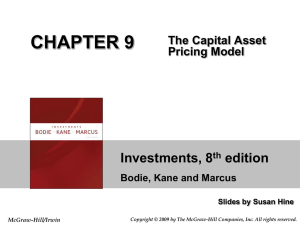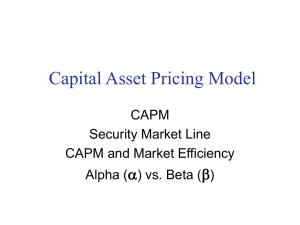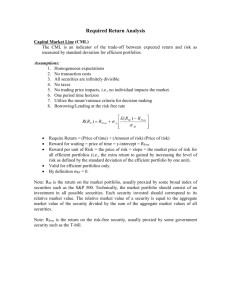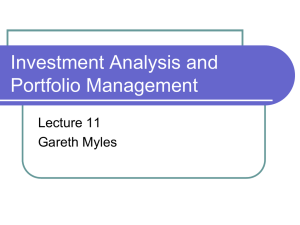No #11
advertisement
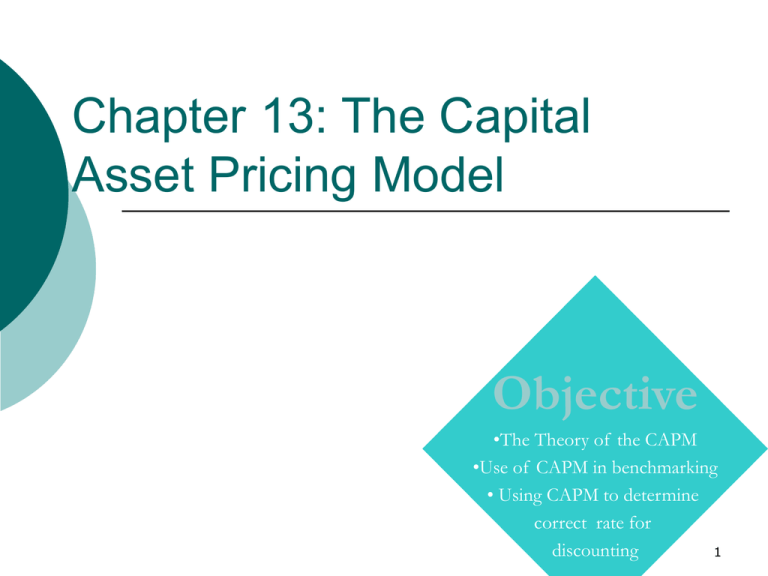
Chapter 13: The Capital Asset Pricing Model Objective •The Theory of the CAPM •Use of CAPM in benchmarking • Using CAPM to determine correct rate for discounting 1 Copyright © Prentice Hall Inc. 2000. Author: Nick Bagley, bdellaSoft, Inc. Chapter 13 Contents 1 The Capital Asset Pricing Model in Brief 2 Determining the Risk Premium on the Market Portfolio 3 Beta and Risk Premiums on Individual Securities 4 Using the CAPM in Portfolio Selection 5 Valuation & Regulating Rates of Return 2 Introduction CAPM is a theory about equilibrium prices in the markets for risky assets It is important because it provides a justification for the widespread practice of passive investing called indexing a way to estimate expected rates of return for use in evaluating stocks and projects 3 CAPM Assumptions 1. 2. Investors agree in their forecasts of expected rates of return, standard deviations, and correlations of the risky securities. Investors generally behave optimally. In equilibrium, when investors hold their optimal portfolios, the aggregate demand for each security is equal to its supply. 4 Market Portfolio Investor’s relative holdings of risky assets is the same, thus the only way the asset market can clear is if those proportions are the proportions in which they are valued in the market place. A portfolio that holds all assets in proportion to their observed market values is called the market portfolio. 5 Market Portfolio Suppose that the market consists of n Assets with values S1 , S 2 ,..., S n , there are m investors with A1 , A2 ,..., Am capitals participating in the markets, and they all invest in proportions 1 , 2 ,..., n in the existing assets. Then we have 6 Market Portfolio S1 , , S n Ai 1 Ai n Ai , i 1,..., m S j j A1 j Am j 1,..., n j ( A1 Am ) j Sj A1 Am Sj M , j 1,..., n 7 The Capital Market Line 20 18 16 Expected Return 14 12 10 8 6 4 2 0 0 5 10 15 20 25 30 35 Standard Deviation 8 The Capital Market Line (CML) m rf r r rf m m rf slope m 9 Determining the Risk Premium on the Market Portfolio CAPM states that the equilibrium risk premium on the market portfolio is the product of variance of the market, 2M weighted average of the degree of risk aversion of holders of risk, A r rf A M 2 M 10 Example: To Determine ‘A’ r 0.14, r 0.20, rf 0.06, M M r rf A M 2 rM r rf A 2 r M M 0.14 0.06 A 2.0 2 0.20 11 Beta The marginal contribution of the security’s return to the standard deviation of the market portfolio’s return i i,M i , M i M i , M i i , M 2 2 M M M 12 CAPM Risk Premium on any Asset According the the CAPM, in equilibrium, the risk premium on any asset is equal to the product of the risk premium on the market portfolio r rf m rf i r rf m rf i i i 13 Market Portfolio Security Market Line 20% Expected Risk Premium 15% 10% 5% 0% -2.0 -1.5 -1.0 -0.5 0.0 0.5 1.0 1.5 2.0 -5% -10% -15% -20% Beta (Risk) 14 The Beta of a Portfolio When determining the risk of a portfolio using standard deviation results in a formula that is quite complex w1r1 w2r2 ... wn rn wi ri 2 2 wi w j ri r j i , j i j i 1,n using beta, the formula is linear 1 2 w r w r ... w r w1 r w2 r ... wn r wi r 11 2 2 n n 1 2 n i i 15 Using CAPM in Portfolio Selection Diversify your holdings of risky assets in the proportions of the market portfolio, and Mix this portfolio with the risk-free asset to achieve a desired riskreward combination. 16 CAPM and Portfolio Selection The portfolio used as a proxy for the market portfolio often has the same weights as well-known stock market indexes such as S&P’s 500 Thus the CAPM strategy in selecting portfolio has come to be known as indexing 17 Indexing 1. 2. Indexing is an attractive investment strategy because As an empirical matter, it has historically performed better than most actively managed portfolios It costs less to implement, no costs of research, less cost of transactions 18 CML, SML and alpha CML provides a benchmark for measuring the performance of the investor’s entire portfolio SML provides a benchmark for the performance of different parts of the whole portfolio alpha: The difference between the risk premium of a portfolio and its risk premium according to SML 19 Positive alpha, Example rf 6% E[rM ] rf 8% M 20% Alpha Fund : 0.5, 1%, 15% 20 Alpha Fund and SML 20 15 Risk Premium 10 5 0 -2.5 -2 -1.5 -1 -0.5 0 0.5 1 1.5 2 2.5 -5 -10 -15 -20 Beta 21 Alpha Fund and CML 20 Expected Return 16 12 8 4 0 0 5 10 15 20 25 30 Standard Deviation 22 Valuation and Regulating Rates of Return Assume the market rate is 15%, and the risk-free rate is 5% A company’s capital structure consists of 80% equity with a beta of 1.3, and 20% dept. The price of one share of the company? 23 Compute the beta company wequity equity wbond bond company 0.80 *1.3 0.20 * 0 company 1.04 24 Valuation and Regulating Rates of Return To find the required return on the new project, apply the CAPM r rf rm rf 0.05 1.040.15 0.05 15.4% 25 Valuation and Regulating Rates of Return Assume that your company has an expected dividend of $6 next year, and that it will grow annually at a rate of 4% for ever, the value of a share is D1 6 p0 $52.63 r g 0.154 0.04 26 CAPM in Practice Empirically it is observed that CAPM does not explain fully the structure of expected returns on assets 27 Explanations 1. 2. 3. CAPM does hold, but the market portfolios used for testing it are incomplete representations of market portfolio Market imperfections, Like borrowing costs are not contemplated in CAPM Greater realism should be added to the modeling assumptions 28 Modifications ICAPM, Intertemporal CAPM In this dynamic model equilibrium risk premiums come from several dimensions of risks, not only from their beta 29 Alternatives APT, Arbitrage Pricing Theory APT gives a rationale for the expected return-beta relation that relies on the condition that there be no arbitrage profit opportunities. APT and CAPM complement each other 30


